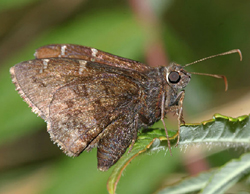Find a Butterfly
Northern Cloudywing
Thorybes pylades
Named
Scudder, 1870

Identification
Wingspan 1 1/4 - 1 3/4". Very similar to Southern Cloudywing. There are several white spots on the forewings including a small grouping along the leading edge and 3 in the center of the wing. Normally these are fewer in number and much smaller than those of the Southern Cloudywing. Spot size varies from individual to individual, however, and occasionally they are large enough to cause confusion between the two species. At close range, one can observe the dark brown palpi (grayish in the Southern Cloudywing). Males have a costal fold on the forewing.
Distribution
British Columbia across Canada to Nova Scotia and south through most of the United States to California, Texas, the Gulf coast, and Florida. Also, Baja and central Mexico. The species occurs throughout New England.
Status in Massachusetts
The Northern Cloudywing is quite common throughout Massachusetts, excepting Cape Cod and Cape Ann, where it is uncommon to rare. Scudder considered it a common New England insect, while Kimball and Jones classified it as infrequent on Nantucket and "apparently rare" on Martha‘s Vineyard. Typically found in small numbers at any one locality. Maximum: 12 at Broad Meadow Brook Sanctuary, Worcester (Worcester Co.) on 1 June 1991, T. Dodd.

Flight Period in Massachusetts
One flight, from late May to early July. [NOTE: Scudder mentions a partial second brood. There is no recent evidence of a second brood in Massachusetts.] Extreme dates: 22 May 1993, Worcester (Worcester Co.), T. Dodd and 19 July 1987, Newbury (Essex Co.), T. French.
Larval Food Plants
Various legumes, including Hair Bush Clover (Lespedeza hirta), Round-headed Bush Clover (L. capitata), Red Clover (Trifolium pratense), White Clover (T. repens), Tick Trefoils (Desmodium, sp.), Alfalfa (Medicago sativa), and Birdsfoot Trefoil (Lotus corniculatus).
Adult Food sources
Found nectaring on 9 species of flowering plants, including blackberries and clovers, by atlas workers

Habitat
Scrubby fields and meadows, sunny grassy areas in woods along wood edges.
Life Cycle
EGG: Very similar, but slightly smaller, than that of Southern Cloudywing. OVIPOSITION: Eggs laid singly on underside of host leaves. LARVA: Dark green, with dark and pale salmon stripes; blackish head and thorax. PUPATION: Occurs within a cell made of several leaves fastened together with silken threads. CHRYSALIS: Dark brown, with lighter wing cases. OVERWINTERING STAGE: Final instar larvae. Like its close relative the Southern Cloudywing, this species emerges relatively late for a species overwintering as a chrysalis. It normally begins to appear just a few days prior to the Southern Cloudywing. Northern Cloudywing males can be very spirited ("pugilistic" in the words of Scudder) and the noted author describes an encounter between this species and a Silver-spotted Skipper: "I once saw one attack the much larger and stronger Silver-spotted Hesperid which had invaded its domain, and drive off the intruder to a great distance by a vigorous onslaught, following its victim with unerring flight in all its twists and turns, and keeping never more than a foot away, both speeding with amazing swiftness; by and by our Northern Cloudy-wing came back victorious to its haunt, but I waited in vain for the other." get description of egg from Scudder
Account Author
Stephen Goldstein



